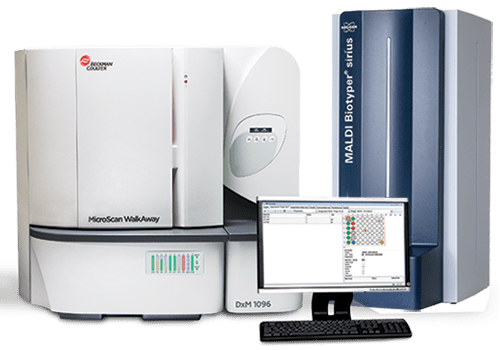MALDI Biotyper is the property of Bruker Daltonik GmbH.
1. “Why Every Hospital Microbiology Laboratory Should Buy a MALDI-TOF.”
ClinLab Navigator. http://www.clinlabnavigator.com/maldi-tof.html. Accessed 9 May 2019.
2. Cromien J. “MALDI-TOF is Poised to Speed Diagnosis for Bacterial and Fungal and Infections.”
Medical Laboratory Observer (MLO), 21 Nov. 2016. https://www.mlo-online.com/diagnostics/microbiology/article/13008880/malditof-is-poised-to-speed-diagnosis-for-bacterial-and-fungal-infections. Accessed 9 May 2019.
3. Burckhardt I and Zimmermann S. “Susceptibility Testing of Bacteria Using MALDI-TOF Mass Spectrometry.”
Front Microbiol, 2018(Aug); 9:1744.
4. Cherkaoui A et al. Comparison of Two Matrix-Assisted Laser Desorption Ionization-Time of Flight Mass Spectrometry Methods with Conventional Phenotypic Identification for Routine Identification of Bacteria to the Species Level.”
J Clin Microbiol, 2010; 48:1169–75.
5. Huang AM et al. “Impact of Rapid Organism Identification via Matrix-Assisted Laser Desorption/Ionization Time-of-Flight Combined With Antimicrobial Stewardship Team Intervention in Adult Patients With Bacteremia and Candidemia.”
Clin Infect Dis, 2013, 57; 1237–45.
6. Delport JA et al. “Quality of Care is Improved by Rapid Short Incubation MALDI-ToF Identification from Blood Cultures as Measured by Reduced Length of Stay and Patient Outcomes as Part of a Multi-disciplinary Approach to Bacteremia in Pediatric Patients”.
PLoS One. 2016;11(8): e0160618.
7. Patel R. “MALDI-TOF MS for the Diagnosis of Infectious Diseases.
Clin Chem, 2015; 61:100–11. doi:10.1373/clinchem.2014.221770.
8. Dingle TC and Butler-Wu SM. “MALDI-TOF Mass Spectrometry for Microorganism Identification.”
Clin Lab Med. 33:589–609. doi:10.1016/j.cll.2013.03.001.
9. Singhal et al. “MALDI-TOF Mass Spectrometry: An Emerging Technology for Microbial Identification and Diagnosis.
Front Microbiol. 2015; 6:791.
10. Murray PR. What is New in Clinical Microbiology—Microbial Identification by MALDI-TOF Mass Spectrometry.”
J Molecular Diagnos, 2012; 15:419–23.
11. Bizzini A and Greub G. “Matrix-assisted Laser Desorption Ionization Time-of-Flight Mass Spectrometry, A Revolution in Clinical Microbial Identification.”
Clin Microbiol Infect, 2010; 16:1614–9.
12. Seng et al. “Ongoing Revolution in Bacteriology: Routine Identification of Bacteria by Matrix-assisted Laser Desorption Ionization Time-of-Flight Mass Spectrometry.” Clin Infect Dis, 2009; 49:543–1.
13. Tan KE et al. “Prospective Evaluation of a Matrix-assisted Laser Desorption Ionization–Time of Flight Mass Spectrometry System in a Hospital Clinical Microbiology Laboratory for Identification of Bacteria and Yeasts: A Bench-by-bench Study for Assessing the Impact on Time to Identification and Cost-effectiveness. “
J Clin Microbiol, 2012;50(10):3301–8.
14. Neville et al. “Utility of Matrix-assisted Laser Desorption Ionization—Time of Flight Mass Spectrometry Following Introduction for Routine Laboratory Bacterial Identification.”
J Clin Microbiol, 2011; 49:2980–4.
 English
English





